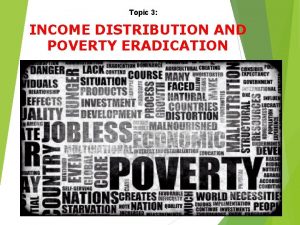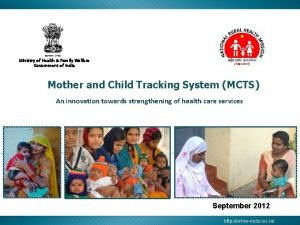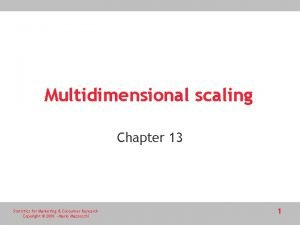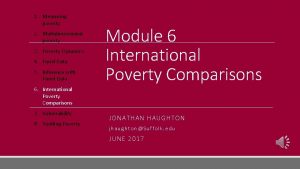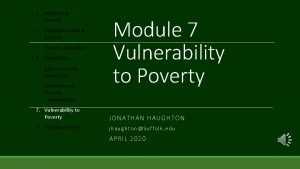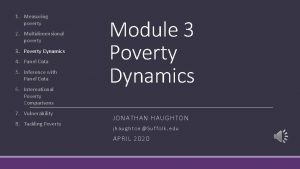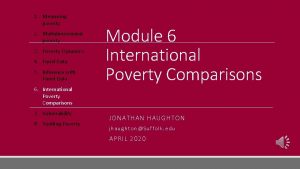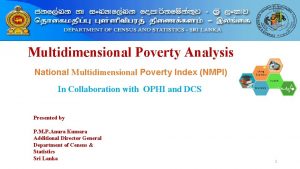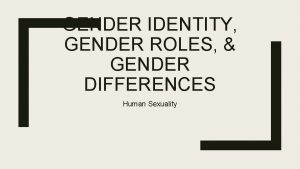Measuring gender differences in multidimensional child poverty Tracking













- Slides: 13

Measuring gender differences in multidimensional child poverty: Tracking progress toward the SDGs UNECE Work Session on Gender Statistics, 15 -17 May 2019, Neuchâtel, Switzerland

OVERVIEW 01. MULTIDIMENSIONAL CHILD POVERTY & THE SDGS 02. GENDER DIFFERENCES IN EXISTING POVERTY ESTIMATES 03. APPROACHES TO MEASURING CHILD POVERTY FROM A GENDER PERSPECTIVE 04. METHODOLOGY 05. PRELIMINARY RESULTS 06. PRELIMINARY CONCLUSIONS/IMPLICATIONS

Multidimensional child poverty and the SDGs • International consensus that poverty is multidimensional • Limitations to monetary approach • SDG 1. 2. 2 Proportion of men, women and children of all ages living in poverty in all its dimensions • Recognition that child poverty should be measured independently of adult poverty • Children’s needs are different than adults • Material deprivations in childhood have lifelong consequences

What defines that a child is multidimensionally poor? Child right violations Child Poverty Nutrition Education Water and Sanitation Health Housing Information B Alabor Child DT NChild HIN OTmarriage GS, Adolescent PO pregnancy VER Violence, etc. TY .

Gender differences in existing poverty estimates • Many empirical advances in individual-level measurement of MD child poverty • But no significant gender differences observed. Why? • Proposal 1 -> few actual gender differences in material deprivation, esp. in early childhood • Proposal 2 -> absence of observed gender differences due to construction of measures • Some dimensions measured at household level & “allocated” to children therein • Individual-level indicators selected without attention to which ones might best capture gender disparities

Approaches to measuring child poverty from a gender perspective • Construct different measures with different indicators for girls and boys • Construct one measure but include girl-specific and/or boyspecific indicators • E. g. access to essential maternal health care/menstrual hygiene products • Construct one measure but assign different thresholds of deprivation for girls and boys for select indicators • Construct one measure w/ same thresholds for all indicators but include additional indicators that are “gender-informed” • Challenges of data availability • But we hypothesize that gender differences in poverty should be observed among older adolescents

Methodology • Dimensions and indicators – Base measure: Education, nutrition, health, water, sanitation, housing & information – Enhanced measure: Incorporation of new indicators into nutrition, water & information dimensions • Anemia prevalence • Whether child spends time fetching water • Mobile phone ownership • Countries and data sources – Sierra Leone and Laos, MICS 6 – Haiti and Guyana, DHS-VI/DHS-V • Unit of analysis – Child aged 0 -17 years • Three age groups: 0 -4, 5 -14, and 15 -17

Methodology (cont’d. ) Multidimensional child poverty measures • We follow the “counting approach” – A child is considered to be multidimensional poor if he/she suffers from deprivation in at least one dimension • We compute two aggregate indexes – The multidimensional headcount ratio (proportion of poor), which accounts for incidence – The average number of deprivations suffered by the poor, which accounts for intensity of multidimensional poverty

Preliminary results Sex/poverty ratio The incidence of multidimensional child poverty among adolescents aged 15 -17 (Gender gaps in relative terms) 1, 5 1 0, 99 1, 07 1, 03 0, 94 1, 01 0, 99 1, 12 0, 5 0 Sierra Leone Laos Baseline Measure Haiti Enhanced Measure Guyana

Preliminary results (cont’d. ) Sex/poverty ratio The intensity of multidimensional child poverty among adolescents aged 15 -17 (Gender gaps in relative terms) 1, 5 1 0, 96 1, 04 1, 02 1, 05 0, 99 1, 04 1, 01 1, 09 0, 5 0 Sierra Leone Laos Baseline Measure Haiti Enhanced Measure Guyana

Preliminary conclusions • It is possible to derive estimates of child poverty in which statistically significant differences between (adolescent) girls and boys are observed – Results suggest that observed differences are related to different experiences of girls and boys, not to construction of measure or choice of indicators • Gender-sensitive design of child poverty measures can provide policymakers with more detailed understanding of how girls and boys may experience poverty differently • But analysis of material deprivation from a gender perspective may be less revealing than analysis of quality of life/well-being

Implications • Disaggregating poverty measures by sex alone may be insufficient for capturing gender differences due to intersectional inequalities the most marginalized face • The challenge of finding indicators to undertake gendersensitive analysis of child poverty relates, in part, to the availability of data in standard surveys • Both issues point to important data gaps on the situation of girls and boys – Better data are needed to ensure neither is left behind in the 2030 Agenda

THANK YOU Lauren Pandolfelli (UNICEF) & Jose Espinoza Delgado (Consultant)
 Distinguish between absolute and relative poverty
Distinguish between absolute and relative poverty Strategic gender needs and practical gender needs
Strategic gender needs and practical gender needs Child poverty in massachusetts
Child poverty in massachusetts Nrhm-mcts
Nrhm-mcts Mother and child tracking system
Mother and child tracking system 전위 순회
전위 순회 Jagged array
Jagged array Multidimensional expressions
Multidimensional expressions Multidimensional database structure
Multidimensional database structure Nigel topnbottom
Nigel topnbottom Chelladurai leadership model
Chelladurai leadership model Distance matrix example
Distance matrix example Multidimensional gradient
Multidimensional gradient Multidimensional scaling marketing
Multidimensional scaling marketing
